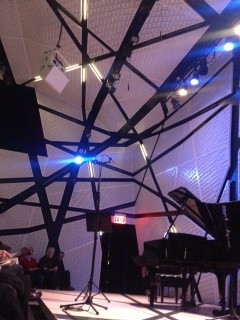
Pierre Boulez has been haunting the New York Philharmonic mercilessly.
On Monday night at the fashionable Williamsburg, Brooklyn venue known as National Sawdust, the recently deceased composer was heard alongside the French contemporary he often hated, Olivier Messiaen, as well as younger somewhat-modernist composers such as George Benjamin and Oliver Knussen. Hosting was a Boulez champion, conductor Esa-Pekka Salonen.
You wouldn’t think that such an evening would be such fun. Oh, but it was.
For the Philharmonic, Salonen is the conductor that got away: the orchestra wanted him for keeps, but he preferred to stick with his Philharmonia Orchestra in London and have more time to compose. But he’s been spending a lot of time in the U.S., including a brilliantly programmed Chicago Symphony Orchestra concert that had an ultra-taut performance of Messiaen normally sprawling Turangalila-Symphonie alongside Debussy’s Syrinx for solo flute and the Ravel Piano Concerto in G.
For the New York Philharmonic, Salonen curated and hosted one of the contemporary-music Contact! concerts, telling fabulous anecdotes for an audience that was clued in enough not just to appreciate it, but to correct his factual lapses. When he talked about Knussen conducting the premiere of his Symphony No. 1 at age 17, somebody interjected, “14.” (According to Wikipedia, it was 15). Later, Salonen mentioned Schoenberg’s Five Piano Pieces, Op. 22 when another listener said “23” (which is correct).
The Boulez stories were not ones that I’d ever heard. When Boulez was asked why he disliked Messiaen’s music so much, he had three words: “Birds and organ.” When running into Salonen in recent years, Boulez complained about conductor Schoenberg’s Piano Concerto and how mundane it was – how each note was doggedly accounted for in the piece’s tone row. When Salonen pointed out that Boulez had just repudiated serialism, Boulez did what he so often did – laughed.
And the music?
The Philharmonic members had clearly worked hard in this remarkably well-prepared program. For Benjamin’s Viola Viola for two violas, violist Katherine Greene claimed they had worked more then 200 hours on the super-intricate, ten-minute-long piece. I’d argue that the music wasn’t actually worth it. What was worth all that and more was the Boulez Sonatine for Flute and Piano, an early, angry, dense work that exploded into existence much like Boulez’s Piano Sonata No. 2 but with flute interlocked into what sounded like a musical volcano. Performers Robert Langevin and Steven Beck were with the score every step of the way. Mindy Kaufman and Stephen Gosling were models of conceptual clarity in Messiaen’s Le Merle noir, one of the composer’s most important birdsong pieces. Not that birdsong wasn’t there before.
There are two kinds of composers, said Salonen: Those who evolve over time and those who seem fully formed from the beginning and just keep writing music the way a bird lays eggs. Messiaen was the latter. And Boulez? Let’s get a Ouija board and ask him.


what in gods name are you babbling about?
haunting? MERCILESSLY!!!!?
“contemporary” music can be fun?
messiaen was a bird laying eggs?
you sure you write for a living?
also you used the word “such” twice in the same sentence. get an editor.
It’s true…I’m not nearly as entertaining as you are. Since Esa-Pekka Salonen came up with the egg comparison, I’ll see if I can get this forwarded to him. I think he’ll enjoy your comment as much as I did.
That is as good a reply I could ever hope to read. Such fun, such taste. I enjoyed it as much as the article. I also will give $50 cash—wait, I’m a “contemporary” composer—$20 cash to Mr. Hertz if that is his real name (haven’t heard that name since the 5th grade), but only if he agrees that he should capitalize God. And Messiaen.